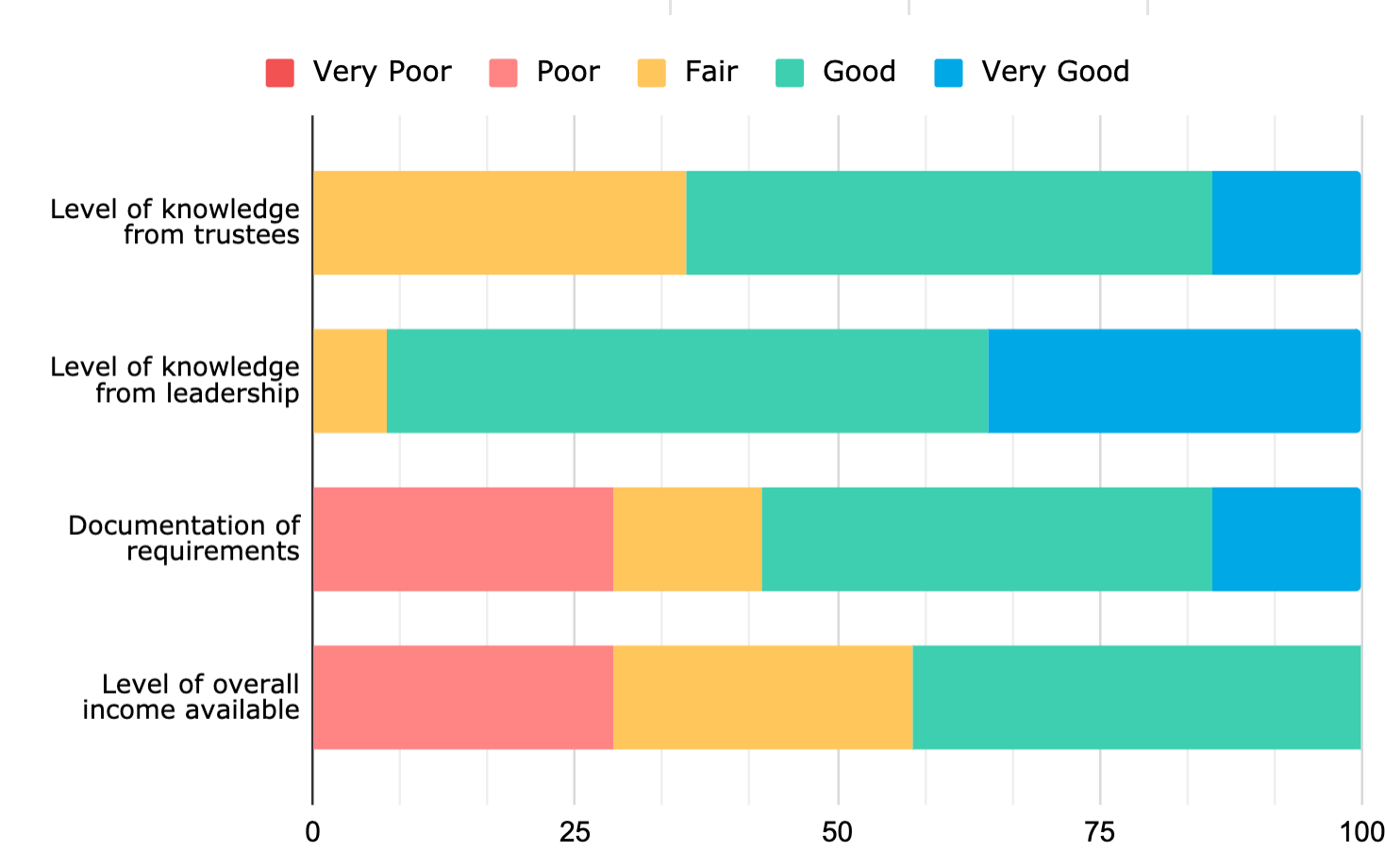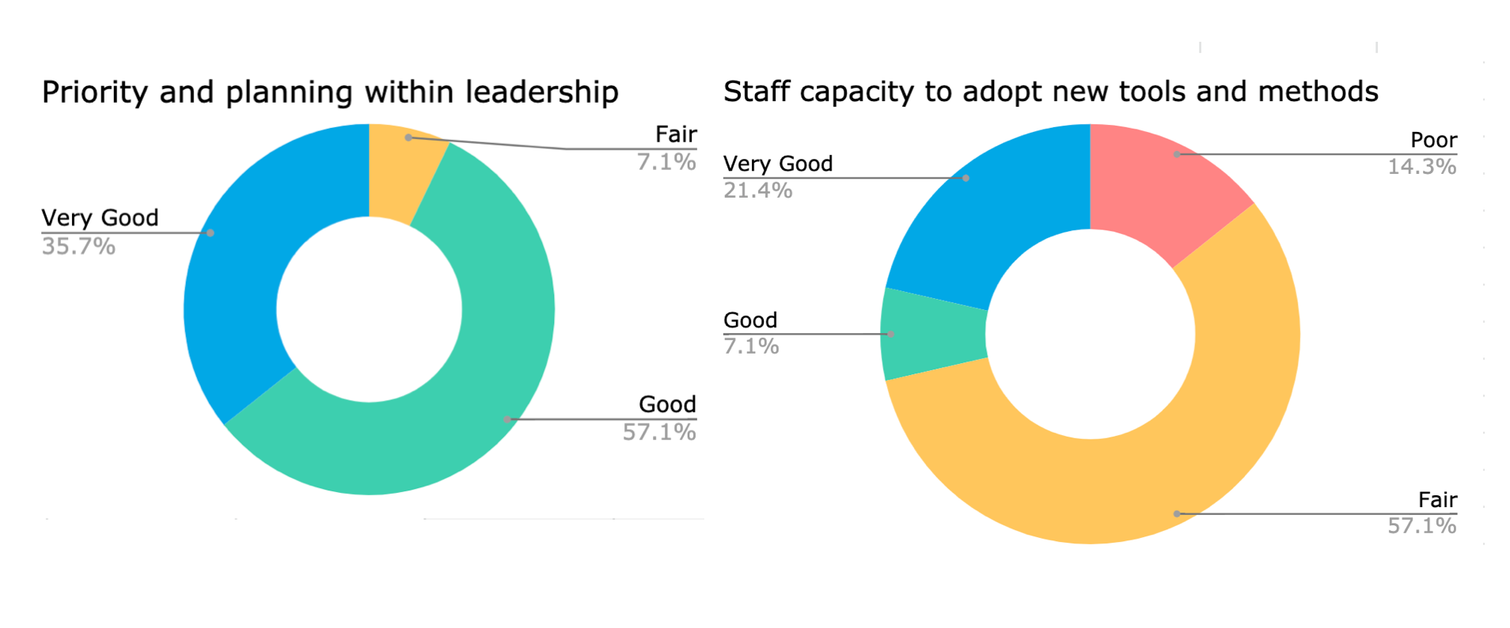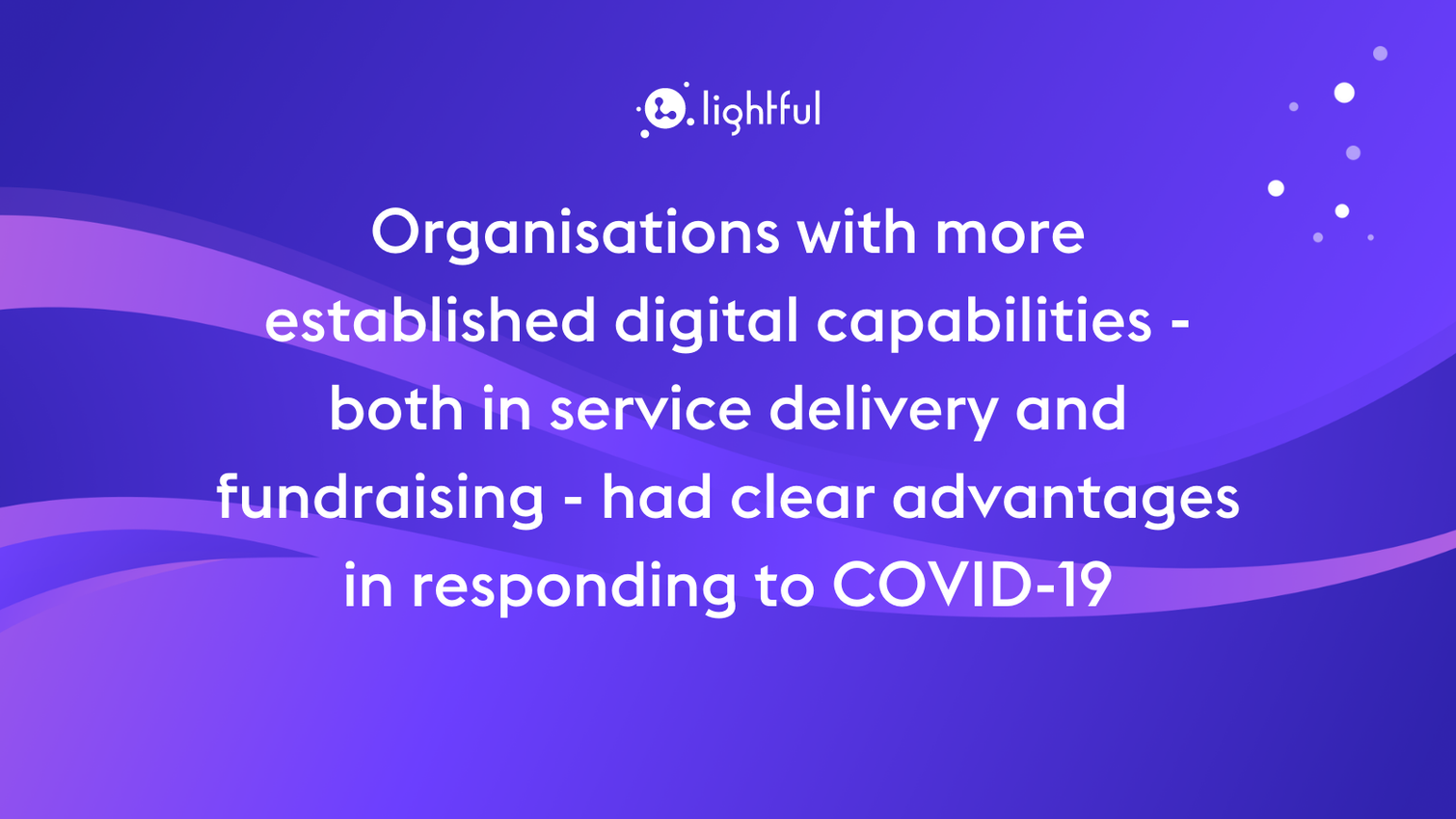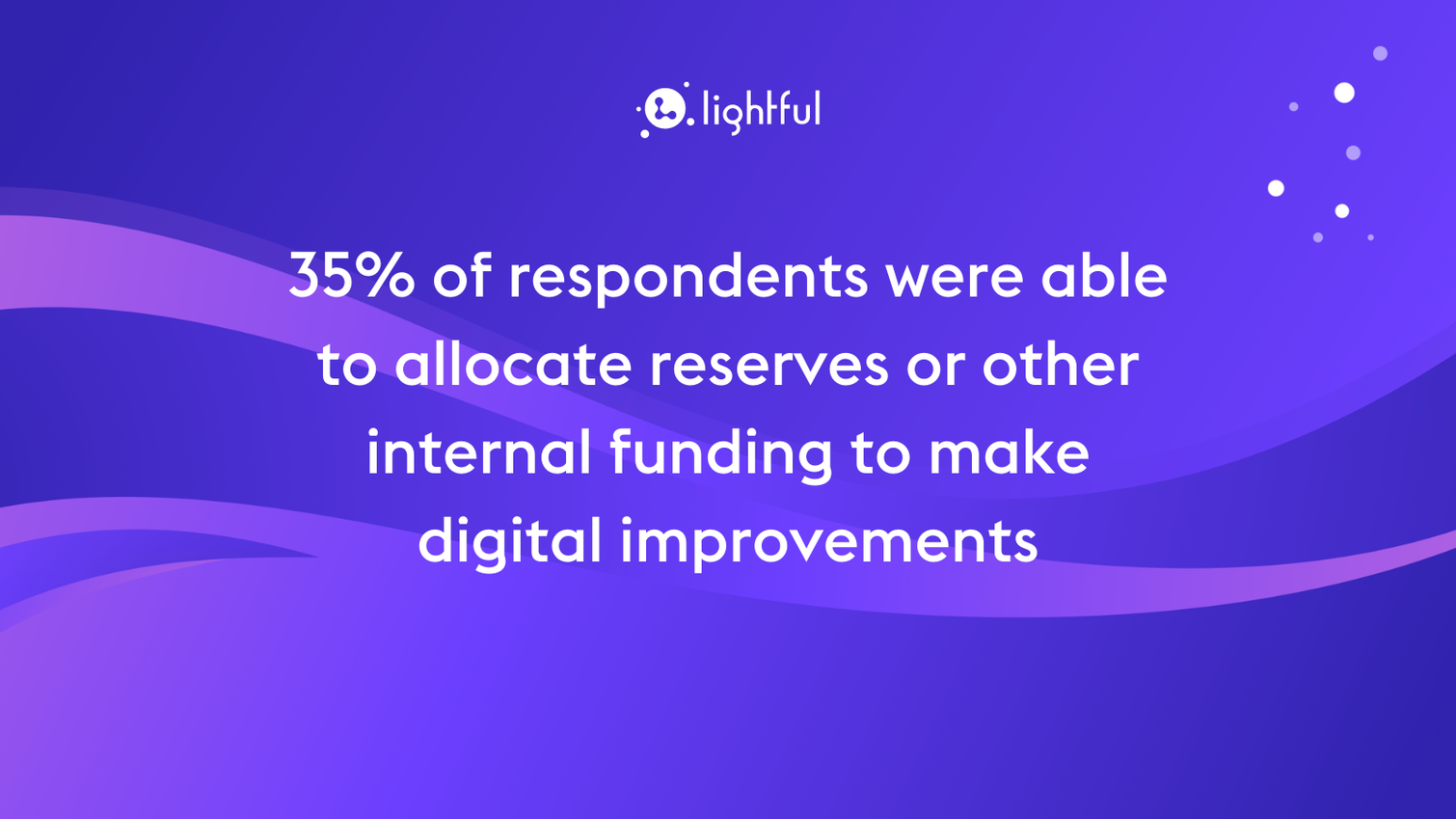Three key learnings in nonprofits’ digital delivery and the impact of COVID-19

Nonprofits around the world have had to change the way they deliver services as a result of COVID-19. A combination of restricted movement, furloughed staff, and increases in demand at a time when forecasted revenue has become more uncertain has created a challenging - at times, impossible - environment in which to make adjustments to delivery models. However, so many nonprofits have shown remarkable resilience, transitioning to virtual delivery models where possible and in many cases, almost overnight. For some, the challenging circumstances have led to accelerated digital transformation and related opportunities.
What can we – as funders, nonprofits, intermediaries in the charity sector - really learn from all these experiences and how can we use this to make concrete steps towards supporting nonprofits with their digital transition?
We wanted to go deeper with nonprofits to better understand answers to this key question, at this key time.
With support from JPMorgan Chase, we surveyed 30 charitable organisations delivering employability, small business development, and financial health support, all of which are more vital than ever given the challenging economic conditions for so many.
This comprehensive survey sought to understand the state of their digital delivery and the impact of COVID-19 in their planning and operations. All respondents were based in the UK and include small, medium and large organisations generating their revenue through various models.
Here are three of our key learnings.
1. Improving digital delivery requires new skills, commitment and capacity
Adopting digital technology has brought new opportunities for many organisations. Many are now able to reach a wider audience with their online services without being limited by certain geographies or other restrictions.
Despite the opportunities, nonprofits also had to overcome several challenges as part of their digital transformation, such as the digital poverty of their end-users, out of date software and the ability to engage remote beneficiaries. Although there appears to be significant digital knowledge and commitment to digital improvements among leadership and trustees of those organisations we surveyed, many struggled to translate this backing into immediate action. Two barriers to using digital to increase impact appear to be a lack of financial resources and staff capacity.
When it comes to using digital to increase impact, how does your organisation perform across the following criteria?

For example, while more than 85% of organisations we surveyed rated their “prioritisation and leadership planning” when it comes to using digital as ‘Good’ or better, only 28% rated their teams’ ability to adopt new tools and methods for this purpose as ‘Good’ or better. The main barriers to using digital to increase impact included documenting requirements, income available and staff capacity.
When it comes to using digital to increase impact, how does your organisation perform across the following criteria?

When it comes to digital delivery, several organisations reported having little to no digital delivery before Covid-19. While all of them have managed to embrace digital in terms of service delivery and internal operations, those that had made previous investments in developing digital skills, tools and practices were able to make the transition more quickly, and potentially, more effectively. Multiple survey respondents cited examples of tools and methodologies implemented prior to COVID-19 that greatly eased the transition to remote working including CRM systems, online messaging systems including Slack, and online productivity software including Google Suite. For those organisations that hadn’t already made the transition to digital tools, it was much harder to upskill team members remotely where a solid digital baseline had not already been established.
In later blogs in this series, we will explore how nonprofits can be supported to develop these digital skills, tools and practices – so they can be more agile, resilient, and responsive down the road. We suggest that it is critical for nonprofits to have a greater understanding of and plan to overcome their digital challenges.
2. Pre-existing capabilities help overcome challenges in funding digital improvements for COVID-19 response
It is evident from survey responses that organisations with more established digital capabilities - both in service delivery and fundraising - had clear advantages in responding to COVID-19. Those organisations that had previously received funding for or invested in digital capabilities were able to weather the storm and continue delivering impact by moving online more efficiently. Pre-existing digital service delivery propositions, with a history of delivering impact, helped these nonprofits provide a stronger case to funders for continued or expanded support.

These same organisations were also raising more money from more sources, and using their agility and capacity to apply for a wider range of grants, tender and income generation opportunities in the midst of the pandemic. These organisations took a pioneering approach to how their services and operations could adapt quickly in response to the impact of COVID-19, and better align with sector funding trends.
Digital skills were typically more embedded across these organisations, with an overarching digital strategy in place that included digital fundraising. Successful digital fundraising requires digital skills combined with an understanding of the mechanics of fundraising.
Effective community fundraisers understand how to tell stories well across digital channels that inspire donors to give through creative and engaging campaigns. And for major gifts, these same principles can be applied using digital tools to better identify, cultivate, solicit, acknowledge, and steward donors. Digital channels can also help funders and donors understand the everyday work of nonprofits, and bring to life the value and impact of initiatives.
Some survey respondents found the competition for emergency funds challenging. Difficulties cited by survey respondents include finding funding to cover core costs, such as staff time to develop new projects, or managing the different impact metrics required by different funders. Some organisations with the confidence and capacity to design and implement new digital services have found new opportunities by signing up to new tender platforms, and others have had success in investing in digital platforms to find trusts that are aligned with respondents’ missions.
As we found out in our digital capacity building BRIDGE programme, resilience and diversity in income sources have given some organisations clear advantages in responding to the COVID-19 crisis. Supporting nonprofits to increase their digital knowledge and confidence delivers increases in income streams across unrestricted funding channels; critically, this additional unrestricted income can then be directed towards further digital initiatives and ultimately builds internal organisational confidence on the benefits of digital. The BRIDGE programme works with international foundations, companies, and donors to build the digital capacity of their grantees and partners by teaching participants the skills they need to increase their effectiveness across digital channels and raise more funds online.

More than 20% of respondents have been able to fund the entirety of their digital improvements by either adapting to the crisis with new fundraising strategies or leveraging active fundraising relationships with major donors or individual donors. 35% of respondents were able to allocate reserves or other internal funding to make digital improvements. In the final blog in our series, we will focus on providing recommendations for funders and examining how providing support with digital can also support the financial sustainability of nonprofits.
3. Scaling digital communication is a priority for many but requires a big leap forward for most organisations
We asked nonprofits about how their communication with stakeholders – end users, volunteers, supporters – has changed, if at all, in light of Covid-19, and what priorities they have around this going forward.
Digital service design, self-service portals for service users, and knowledge bases for service users emerged as the top digital priorities.

Many have already adjusted the way they communicate with stakeholders, using digital: 79% of respondents have increased their use of digital for service design, 50% of respondents have increased their use of self-service portals for service users, and 42% have increased their use of a knowledge base for service users (a knowledge base provides service users with a self-service library of information enabling users to find answers or guidance to their questions).
However, this remains an area of development for many: 67% of respondents noted they need to improve their use of digital for service design, 70% of respondents noted that they now needed to improve or create their knowledge base for service users, and 63% noted that they needed to improve or create a self-service portal for service users.
It’s interesting to see that each organisation surveyed had different areas they wanted to explore and develop on their digital journey, and this applies to organisations with advanced digital skills as well as ones with more limited capacity. Every nonprofit can benefit from an assessment of their digital skills; this assessment can help organisations understand how effectively they are using digital across functions, and to identify areas of improvement. We will be exploring the clear and consistent approaches that can be used to support organisations on their individual journeys in subsequent blogs.
What is coming next
We are launching a series of blogs with more detailed findings after working with many survey respondents in more depth, to better understand how organisations are considering their options and planning for the future. Our next blog will examine how nonprofits can understand and prioritise the digital issues they are facing, and our third blog will explore how nonprofits can better understand what technologies best meet their needs, and how they can create and implement a plan for these new technologies. Our fourth blog will conclude the series and provide recommendations and practical guidance for funders and nonprofits to apply these learnings.
As we have found in our survey analysis, alongside our BRIDGE programmes and other projects with clients, those organisations that had already started their digital transformation journey prior to the COVID-19 crisis were much better placed to leverage their capabilities to adapt their services and income generation to the “new normal”. But there are important steps organisations earlier in this process can do.
We are committed to sharing our learnings with the sector and we will be creating more insights on how more organisations can overcome the challenges we discussed here, particularly translating commitment from funders, leaders and governance to better tools, skills and outcomes.
Latest articles

In a world of growing uncertainty, small and local non-profit organisations often find themselves with competing priorities and struggle to plan how to allocate their available resources. Despite the increasing demand for their vital work, they are not always able to allocate the funds they receive to strategic planning and future growth.

As the world becomes more digitally-focused, it’s essential for nonprofits to have a digital presence. With more and more options for online engagement, we know that this can be challenging for nonprofits to tackle. But, we also know that it is a huge opportunity to increase audience engagement, awareness and fundraising. To help nonprofits navigate this, we’re going to explore the “whys” and “hows” of creating a nonprofit digital strategy. We’re even providing a free digital strategy canvas to help nonprofits improve their online presence in just a few steps.
Related posts

As the world becomes more digitally-focused, it’s essential for nonprofits to have a digital presence. With more and more options for online engagement, we know that this can be challenging for nonprofits to tackle. But, we also know that it is a huge opportunity to increase audience engagement, awareness and fundraising. To help nonprofits navigate this, we’re going to explore the “whys” and “hows” of creating a nonprofit digital strategy. We’re even providing a free digital strategy canvas to help nonprofits improve their online presence in just a few steps.

We’ve been hearing a lot about the metaverse lately and nonprofits that we work with are wondering what the emerging technology means to them. It’s difficult to get your head around something so new and different so we wanted to try to dig into it to understand more.
See who we help
Contact us
Want to learn more?
Email Jonathan and start a conversation





